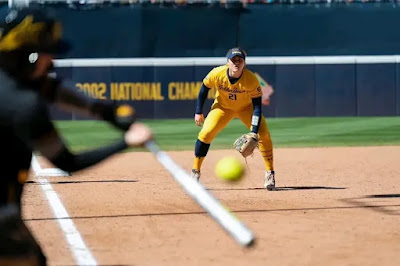How to Boost Your Softball Swing & Bat Speed with 7 Tips
One of the key factors that affect your softball swing is how you hold the bat. The way you grip the bat, the amount of pressure you apply, and the angle of your grip can make a big difference in your bat speed. If you follow these simple guidelines, you will surely see your bat speed increase!
 |
| How to Boost Your Softball Swing & Bat Speed with 7 Tips |
Finger Grip
When we teach students, we use a simple trick to help them get the right finger grip. We take a batting glove and draw a line across it from the index finger to the bottom. This helps us keep our hand and our bat on top of the finger grip, which is what we want. If we can prevent the bat from slipping into the palm of the hand, we will have more flexible wrists.
Approach
How do you normally get a bat? I hold it like a handshake. That's all there is to it. I do this whether I am picking up a bat or someone is giving me one. All you have to do is take the bat and shake hands with it and pull it in. And then you have the top hand in place. Do the same thing with the bottom hand if you are shaking with your left hand. Your grip should be relaxed and your finger grip should be above the line we drew, not below it near the thumb.
One thing you can do is simply extend the bat in front of you and see if you can squeeze the bat between your thumb and your index finger. If you can, then you have a good finger grip. If you are only squeezing with your thumb and not your index finger, your bat movement will be slow. Out is faster. We want to keep our wrists loose. We want to have a fast bat speed. We want to be able to explode our hands and our wrists towards the ball.
Hand Position
The next thing we want to pay attention to is where we place our hands relative to our body. We want to try to keep the bat up high. The bottom hand should be about as high as the highest pitch, the highest strike - the pitch that is at the top of the strike zone - and opposite the armpit. We maintain this position and bring the bat and then the hands to the ball.
We want to have a power position with both the lead arm and the top arm. We need both arms to be powerful. In the power position, you should see your elbow pointing straight at the target, towards the pitch. You want to be careful not to get too close. You will see some hitters who are too close and then they can't swing their arms quickly. And remember we are looking for a quick swing. So we have a little bit of room, about as wide as your hand, between your body and your arm, but still in a power position.
Elbows
Elbows are down. We often see elbows up. What happens then, as a hitter, is that we wrap around. It's hard to go against gravity. We are in this position, with the bat at about one o'clock, and as soon as we lift that elbow up, we want to shorten the distance it takes to get to the ball. We have to lift it against gravity, then swing it all around. And because of how our body is built, we tend to lower that back shoulder as we go down. So let's make sure we don't wrap around the ball. Go straight through it. So the elbow moves across in the power position, and they are pointing down mostly, and the back elbow is slightly higher than the front one.
The Front Arm
The lead arm should form a right angle between your upper arm and your lower arm. If you lift it too high, you will end up wrapping it around.
Shoulders
Shoulders should be relaxed. If one shoulder is lower than the other, it should be the front shoulder. If you begin like this, you have a risk of dropping more and more or having to lift the bat back up. So it's better to start with it slightly down. Or just completely level. Either way, but if you make a mistake, make it with it down a bit.
Stance
When you get your stance, we also want to be level. Everything is level. If you face a good drop pitch or a good rise pitch, you will miss it because the bat will go down and you will hit the ball in the air. So keep your knees level and you will do well.
There are a few other things I want to mention about the stance. How far do we stand?
I also want to talk about the difference between an open stance and a closed stance. When I close my stance, which means I move the back foot farther away from the plate than the front foot (in other words, I turn my body away from the pitcher), notice how the bat moves. The distance from the bat to the contact point gets longer and we want to keep it short and powerful. So if you have a very fast swing, very strong hands and wrists, you might be able to use a closed stance. But usually, you will see most people have a square stance.
If you still have trouble swinging the bat, you might try an open stance. That brings the bat closer to the ball before the ball is even thrown by the pitcher. So with our closed stance, if we start with a square stance and we open it up, now we are facing the pitcher more. But when we start closing it up, you see it's a long way to go for an inside pitch. And that's the pitch that often will be thrown because you are weak to it. So start with a parallel stance or a square stance, both feet about the same distance from the plate. Stay close to the plate a bit so that you can hit some of the balls before they curve. Before the rise goes up, before the out curve moves away, and before the drop pitch falls down. This makes it easier to hit. You won't gain much time because of the speed. But you will hit more pitches.





